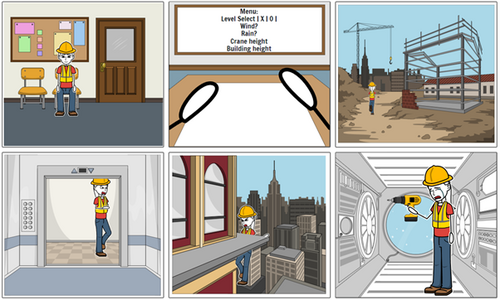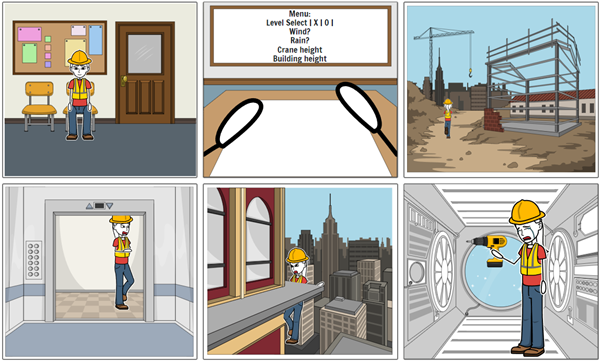Assignment 4

Introduction
Working at great heights is a dangerous job done by only the most skilled. But even the most skilful people start somewhere, with this application, it allows a safe starting place for crane technicians to learn and practice safe procedures while doing their work.
Description of Application
The purpose of this application is to allow for the training of crane technicians, specifically the processes they should follow when performing maintenance at a great height. Most crane technician certifications are good at giving the trainee an idea of how they should organise themselves when performing maintenance. However, in order to learn how to practically apply these skills they will need to practice on a real crane under supervision. Although this does give them good training there are dangers associated with this activity.
Namely that they are performing these tasks at a great height. They do have supervision but there is always the possibility that they might fall and injure themselves or even die if they or the supervisor lose focus for even a second. Ideally the trainee would be able to practice their skills in as safe an environment as possible before attempting the real thing.
The application we are designing is going to allow for its users to get used to the idea of scaling high places to perform maintenance while making sure they follow safety precautions. The main point is not that it teaches them how to repair a crane but that they need to be aware of the various issues/scenarios that may arise when doing maintenance and can react accordingly as well as the precautions they must take at all times. The trainee will be able to get used to the routine of their work in a safe environment so that when they are able to practice in a real situation they will already have the correct mindset for the job.
According to a study by Abich IV et al. (2021) training in immersive virtual reality applications improves trainees' knowledge acquisition and retention compared to more traditional methods such as instructor presentations. The application should be as close to the real thing as possible, at least in terms of what steps trainees need to perform when performing their tasks. The interactivity of VR was considered to be a contributing factor to the increased performance of trainees, especially on knowledge tests. The application should not be used as a replacement for current training methods but instead act as an augment that assists in the trainees learning process.
Sacks et al. identified in their 2013 study that virtual reality could be effective in teaching construction workers how to identify risks at their job sites. They found that the VR experience tends to hold their attention better than traditional classroom learning as the trainees were given more ‘hands on’ control that improved their immersion. As such this application needs to offer control to the users to reinforce the lessons they are being taught. A VR simulation being used as a precursor to on site training will help to improve the safety of the trainees by reinforcing what they are being taught in the classroom as well as providing them a safe space to make mistakes and learn.
Description of Interface
The application utilises a VR interface technology to simulate the dangerous environments that technicians working on a crane might face. The use of the VR interface allows for the simulation of these specific scenarios to be far more engaging and immersive experience than if a more traditional interface technology was used. This is particularly important for this application as it provides a unique way to educate and prepare individuals for the various conditions and dangers of working at such heights. “Safe Work Australia” defines any construction work with a risk of falling more than 2 metres as high-risk construction work. (https://www.safeworkaustralia.gov.au/safety-topic/hazards/working-heights) “Safe Work Australia” found that, in Australia, from 2015-2019 there were 122 fatalities due to falls from a height. (https://www.safeworkaustralia.gov.au/doc/falls-data-infographic)
This application aims to reduce the likelihood of an incident occurring by exposing workers to safety procedures in an environment similar to the one they would be working in. This cannot be done to the same effect with standard interface technologies. According to research by the “PWC” employees training in VR were up to four times quicker at completing their training than standard training. (https://www.pwc.com.au/digitalpulse/virtual-reality-vr-training.html) So not only can an application such as this provide a more realistic training environment it can also speed up the training process considerably.
Interaction Design
The application has several interactions due to the various actions required to teach the end users. We aim to have the user climb up the crane while making sure to manage their harness safely on the way up. Once the user is on top of the crane, we are planning to have a task to be completed such as taking a drill off your belt or welding something to the crane. We thought that it would be safer and easier to teach people safe practices on cranes in VR rather than in real life, to that end we aim to have climbing feel as realistic and train the same skills and movements that’d be needed to do the actions on a real crane.
The harness mechanic was added so the user is properly trained to use and manage their harness in real time in case any unexpected events occur, it’s important for the user to be trained to manage their harness while climbing so it becomes routine, and they don’t forget about it. The tasks at the top of the crane have been added so we can teach the users about the safety practices required while up there, our aim isn’t to teach them how to weld/drill, but rather the practices they should be using to ensure the safety of themselves, their tools, and others around them.
We have a menu where the user can configure and select various options to change the scenario that they’ll have to work in, we decided to make the menu in an office room utilising world space rather than screen space because we feel like it is more cohesive to the general design and flow of the application. We have created a storyboard illustrating the general sequence of events the user will go through, from selecting options in the menu, to ascending the crane and finally working on the crane at the top.

Initial Technical Development
This application is being developed in Unity 3D and is being aided in its development through the use of the Oculus Integration package available on the Unity asset store. The Oculus Integration package allows development support for Oculus VR and some other supported devices. The Oculus Integration package is extremely helpful as it provides many prefabs and premade scripts to make the implementation of some interactions and features quite easy and helps lay a very solid foundation to the beginning of any VR application.
Initially, various interactions and designs were chosen and planned out properly, this meant the interactions later on would not be meaningless to the purpose. Some of these interactions have already begun being developed and are still not fully implemented and some are still being planned. Climbing is one main mechanics that is being developed and will be ready for testing.
The climbing interaction is a “simple” movement interaction, however as mentioned in the Interaction Design, just because it is simple it is still an incredibly important aspect of the interactions in this specific context. The climbing will be simulated, this means the player will physically have to place each hand above the next in order to climb.
The menu select will be a world space menu in which the user will be able to physically reach and touch options. This will be inside a building similar to that of an office.
The clipping of the user’s harness, to various points along the climb and when they are at the top is another interaction. This will involve the player grabbing a clip and moving it to another clip at intervals up and down the climb.
Another interaction that is being planned and hopefully soon to be implemented is a task to complete at the top of the crane. This will involve something like taking a drill off your belt or using a welder. This obviously is not the most important aspect of the application as the safety practices is what we are trying to teach.
Initial 3D Models
Most of the models we plan to use will be made by members of our group, so far only the Crane model is complete, however the others will be completed soon. The only object currently that we have decided to download is the carabiner.
Crane:

This crane was created in blender by our team and is used as part of the environment and situation the user of our application will be placed in. The user will climb this crane.
Buildings:
Currently the buildings have not been made, hence no image, but they will be used to create the environment the user is in and will be there for no other reason than visual purposes.
Office:
The office also has not yet been created however its purpose will be to act as a menu for the user. In the office, the user will be able to select from different options such as weather conditions and different tasks to complete and will be where to user starts.
Carabiner:

The carabiner is one object that we did not create and was downloaded from sketchfab. This object will be attached to the users side and have another one dangling from it by a rope. This will be what the user continues to attach to the ladder as they climb.
Conclusion
Our application is designed to help train users on the various safety practices required for operating on a crane. We’re using VR because it’s easier to create various scenarios to fully test the user on their skills and practices in a fully safe and efficient way.
References
Abich IV J, Parker J, Murphy, J, Eudy M, 2021 A review of the evidence for training effectiveness with virtual reality technology, Virtual Reality, DOI: 10.1007/s10055-020-00498-8
Sacks, R, Perlman A, & Barak, R, 2013 Construction safety training using immersive virtual reality, Construction Management and Economics, DOI: 10.1080/01446193.2013.828844
https://www.safeworkaustralia.gov.au/safety-topic/hazards/working-heights
https://www.safeworkaustralia.gov.au/doc/falls-data-infographic
https://www.pwc.com.au/digitalpulse/virtual-reality-vr-training.html
https://sketchfab.com/3d-models/carabiner-fe3ecff6d84a4464a85ee97695b4ef7f
Get KIT208 - Assignment 4 & 5
KIT208 - Assignment 4 & 5
| Status | Released |
| Authors | Losmada, Leo Headley |
More posts
- Assignment 5Oct 22, 2022
- Test PlanOct 06, 2022
Leave a comment
Log in with itch.io to leave a comment.